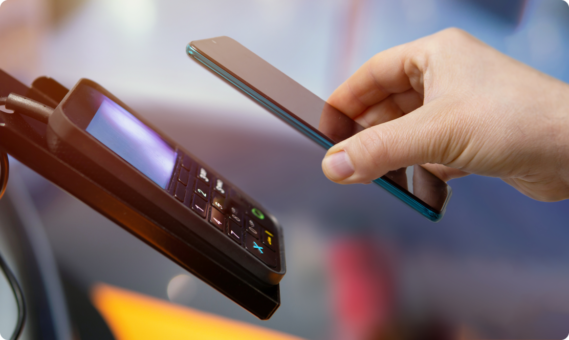
Reporting & Insights

Reporting & Insights
Contactless payments have become increasingly popular in the last several years and are quickly becoming the preferred ultimate payment method. A study by Juniper Research estimates that as we push further toward a cashless society, the value of contactless transactions will skyrocket to reach $10 trillion globally by 2027.
The COVID-19 pandemic had a hand in accelerating the popularity and development of contactless payments. With contactless payment options, payers can keep their social distance—no card or cash ever changes hand—but added benefits of convenience, security, reliability, and efficiency have made contactless options a mainstay for paying for and managing business expenses.
Contactless payment systems use Near Field Communication (NFC) or radio-frequency identification (RFID) technology to wirelessly connect the payment method and point-of-sale terminal in proximity of one another.
In other words, customers can just tap or hover their contactless option over the terminal/POS system, and bam! Touchless payment complete. No more cash, swiping magnetic strips, or inserting chip card necessary. Instead, customers can use the following options to complete contactless transactions.
If you prefer using a physical card, you still have the option to go contactless. Most cards now have an NFC chip embedded in them.
Typically, we all do our best to always leave the house with keys, phone, wallet, but nowadays you can feed two birds with one phone. In fact, 15% of digital-wallet users say they leave their residence regularly without the physical alternative.
Virtual cards are stored in digital wallets (Apple Pay, Google Pay, and Samsung Pay) on smartphones, wearable devices like smartwatches, and other mobile devices with built-in NFC technology.
With virtual cards, you and your employees don’t have to wait for physical corporate credit cards to be sent in the mail. Instead, virtual cards can be issued, activated, and used instantly.
Once activated, virtual cards make transactions a breeze and are up to 10 times faster than other payment methods. No digging through a wallet to find the right card. No swiping or inserting. No waiting. The tap-and-go option saves time and effort so employees can carry on and focus on more important tasks.
Additionally, employees don’t have to keep and carry stacks of receipts to submit for reimbursement. Transaction records are conveniently stored in digital wallets with their virtual cards so it’s simple to look back at payment history. Employees can also easily screenshot digital receipts for reimbursement later.
Compared to traditional debit or credit cards, contactless options offer enhanced security. Any card, personal, or business information hosted in digital wallet systems is secured by encryption and tokenization, which ensures that sensitive card information is not shared during the transaction and reduces the chances of fraudulent activity. To add another layer of security, you can also set up two-factor authentication in your digital wallet, not only to log in to the app but to process each transaction.
Additionally, you don’t run the risk of losing a card or having it stolen, but if you do have security concerns, virtual cards can easily be turned off or on through your banking app.
Another advantage of contactless payments for corporate expenses is the accessibility and global acceptance they offer. Whether employees are traveling domestically or internationally, contactless payments are widely accepted, making it easy to handle expenses in different locations. This eliminates the need for employees to carry large amounts of cash or worry about currency conversions, making corporate travel more convenient and efficient.
You want (and need) to have control over your business expenses and employee spending. Contactless payments paired with spend management software gives you that control and streamline expense management processes. With U.S. Bank’s new business spend management software, for instance, businesses get a suite of customized card controls so you can choose where, when, and how your employees use business funds.
Contactless payments capture valuable data for businesses to analyze and optimize their expenses, but acting on and reconciling those expenses can still be cumbersome. However, when companies integrate their contactless options with expense spend management software, transactions are automatically recorded and categorized, reducing the burden on finance teams to manually categorize transactions one-by-one.
Additionally, with integrated reporting tools, companies can gain insights into spending patterns, identify areas of potential cost savings, and make informed decisions about expense management. This data-driven approach can help companies optimize their budgeting processes and improve overall financial management.
As the world continues its digital transformation and businesses adapt to the modern world of digital payments, the convenience, security, efficiency, and simplicity of contactless payment methods will enhance your financial management practices. And with the added support of a powerful spend management platform, you gain unparalleled control and visibility over your expenses.
Want to learn more about how your company can take advantage of U.S. Bank’s virtual cards and spend management software? Explore more here.